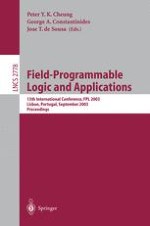This book contains the papers presented at the 13th International Workshop on Field Programmable Logic and Applications (FPL) held on September 1–3, 2003. The conference was hosted by the Institute for Systems and Computer Engineering-Research and Development of Lisbon (INESC-ID) and the Depa- ment of Electrical and Computer Engineering of the IST-Technical University of Lisbon, Portugal. The FPL series of conferences was founded in 1991 at Oxford University (UK), and has been held annually since: in Oxford (3 times), Vienna, Prague, Darmstadt,London,Tallinn,Glasgow,Villach,BelfastandMontpellier.Itbrings together academic researchers, industrial experts, users and newcomers in an - formal,welcomingatmospherethatencouragesproductiveexchangeofideasand knowledge between delegates. Exciting advances in ?eld programmable logic show no sign of slowing down. New grounds have been broken in architectures, design techniques, run-time - con?guration, and applications of ?eld programmable devices in several di?erent areas. Many of these innovations are reported in this volume. The size of FPL conferences has grown signi?cantly over the years. FPL in 2002 saw 214 papers submitted, representing an increase of 83% when compared to the year before. The interest and support for FPL in the programmable logic community continued this year with 216 papers submitted. The technical p- gram was assembled from 90 selected regular papers and 56 posters, resulting in this volume of proceedings. The program also included three invited plenary keynote presentations from LSI Logic, Xilinx and Cadence, and three industrial tutorials from Altera, Mentor Graphics and Dafca.
